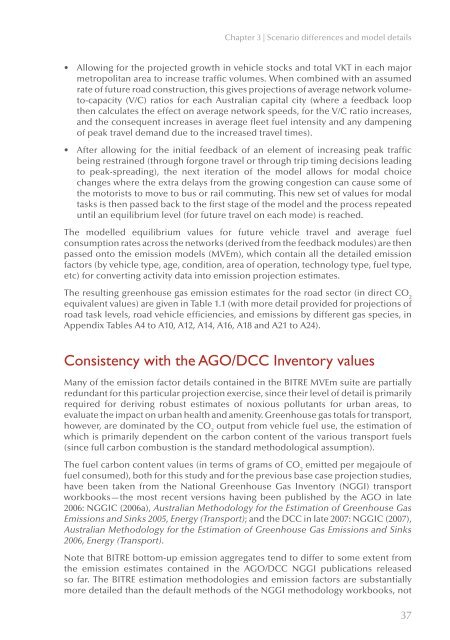PDF: 9795 KB - Bureau of Infrastructure, Transport and Regional ...
PDF: 9795 KB - Bureau of Infrastructure, Transport and Regional ...
PDF: 9795 KB - Bureau of Infrastructure, Transport and Regional ...
You also want an ePaper? Increase the reach of your titles
YUMPU automatically turns print PDFs into web optimized ePapers that Google loves.
Chapter 3 | Scenario differences <strong>and</strong> model details<br />
• Allowing for the projected growth in vehicle stocks <strong>and</strong> total VKT in each major<br />
metropolitan area to increase traffic volumes. When combined with an assumed<br />
rate <strong>of</strong> future road construction, this gives projections <strong>of</strong> average network volumeto-capacity<br />
(V/C) ratios for each Australian capital city (where a feedback loop<br />
then calculates the effect on average network speeds, for the V/C ratio increases,<br />
<strong>and</strong> the consequent increases in average fleet fuel intensity <strong>and</strong> any dampening<br />
<strong>of</strong> peak travel dem<strong>and</strong> due to the increased travel times).<br />
• After allowing for the initial feedback <strong>of</strong> an element <strong>of</strong> increasing peak traffic<br />
being restrained (through forgone travel or through trip timing decisions leading<br />
to peak-spreading), the next iteration <strong>of</strong> the model allows for modal choice<br />
changes where the extra delays from the growing congestion can cause some <strong>of</strong><br />
the motorists to move to bus or rail commuting. This new set <strong>of</strong> values for modal<br />
tasks is then passed back to the first stage <strong>of</strong> the model <strong>and</strong> the process repeated<br />
until an equilibrium level (for future travel on each mode) is reached.<br />
The modelled equilibrium values for future vehicle travel <strong>and</strong> average fuel<br />
consumption rates across the networks (derived from the feedback modules) are then<br />
passed onto the emission models (MVEm), which contain all the detailed emission<br />
factors (by vehicle type, age, condition, area <strong>of</strong> operation, technology type, fuel type,<br />
etc) for converting activity data into emission projection estimates.<br />
The resulting greenhouse gas emission estimates for the road sector (in direct CO 2<br />
equivalent values) are given in Table 1.1 (with more detail provided for projections <strong>of</strong><br />
road task levels, road vehicle efficiencies, <strong>and</strong> emissions by different gas species, in<br />
Appendix Tables A4 to A10, A12, A14, A16, A18 <strong>and</strong> A21 to A24).<br />
Consistency with the AGO/DCC Inventory values<br />
Many <strong>of</strong> the emission factor details contained in the BITRE MVEm suite are partially<br />
redundant for this particular projection exercise, since their level <strong>of</strong> detail is primarily<br />
required for deriving robust estimates <strong>of</strong> noxious pollutants for urban areas, to<br />
evaluate the impact on urban health <strong>and</strong> amenity. Greenhouse gas totals for transport,<br />
however, are dominated by the CO 2<br />
output from vehicle fuel use, the estimation <strong>of</strong><br />
which is primarily dependent on the carbon content <strong>of</strong> the various transport fuels<br />
(since full carbon combustion is the st<strong>and</strong>ard methodological assumption).<br />
The fuel carbon content values (in terms <strong>of</strong> grams <strong>of</strong> CO 2<br />
emitted per megajoule <strong>of</strong><br />
fuel consumed), both for this study <strong>and</strong> for the previous base case projection studies,<br />
have been taken from the National Greenhouse Gas Inventory (NGGI) transport<br />
workbooks—the most recent versions having been published by the AGO in late<br />
2006: NGGIC (2006a), Australian Methodology for the Estimation <strong>of</strong> Greenhouse Gas<br />
Emissions <strong>and</strong> Sinks 2005, Energy (<strong>Transport</strong>); <strong>and</strong> the DCC in late 2007: NGGIC (2007),<br />
Australian Methodology for the Estimation <strong>of</strong> Greenhouse Gas Emissions <strong>and</strong> Sinks<br />
2006, Energy (<strong>Transport</strong>).<br />
Note that BITRE bottom-up emission aggregates tend to differ to some extent from<br />
the emission estimates contained in the AGO/DCC NGGI publications released<br />
so far. The BITRE estimation methodologies <strong>and</strong> emission factors are substantially<br />
more detailed than the default methods <strong>of</strong> the NGGI methodology workbooks, not<br />
37

















